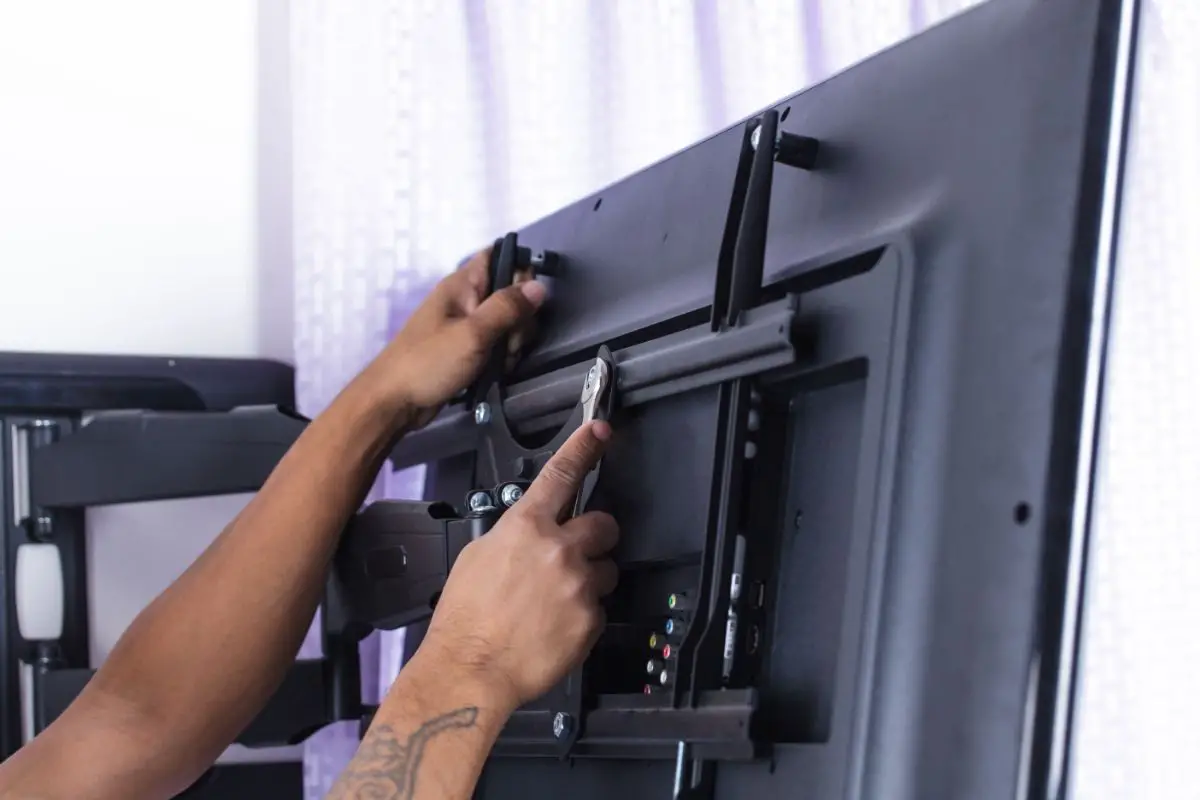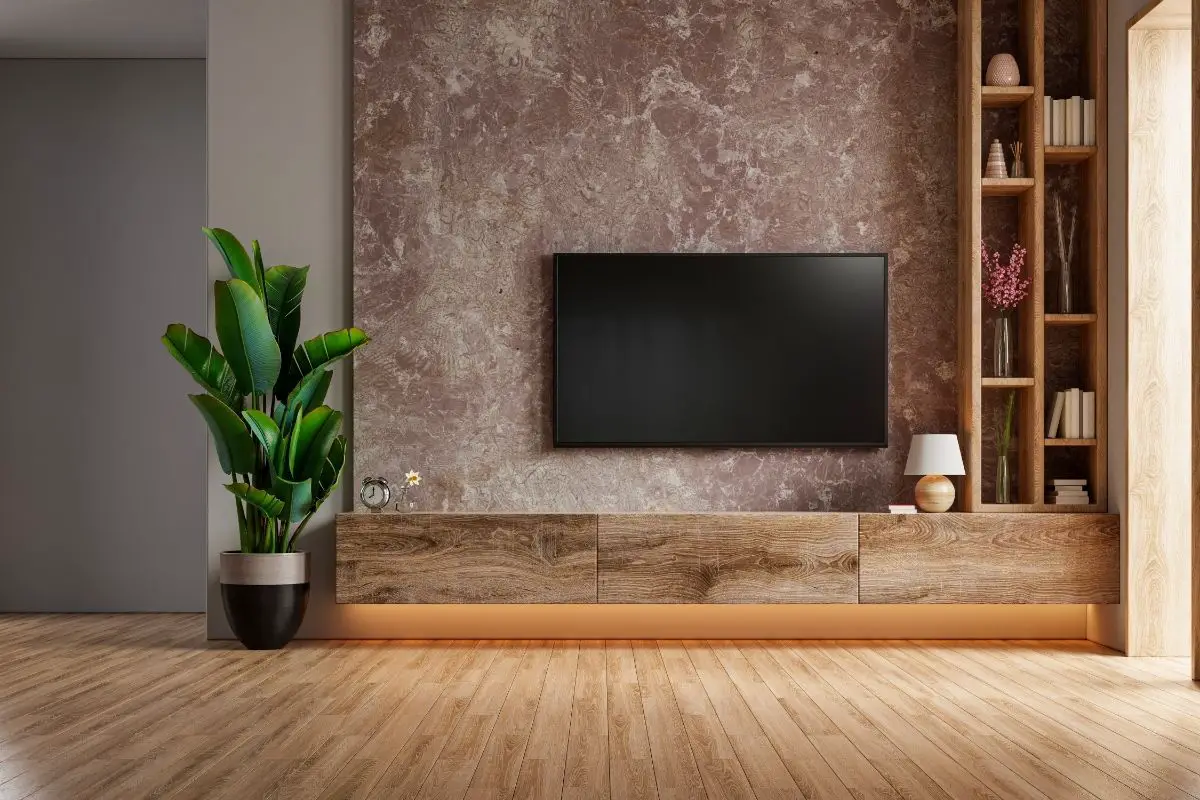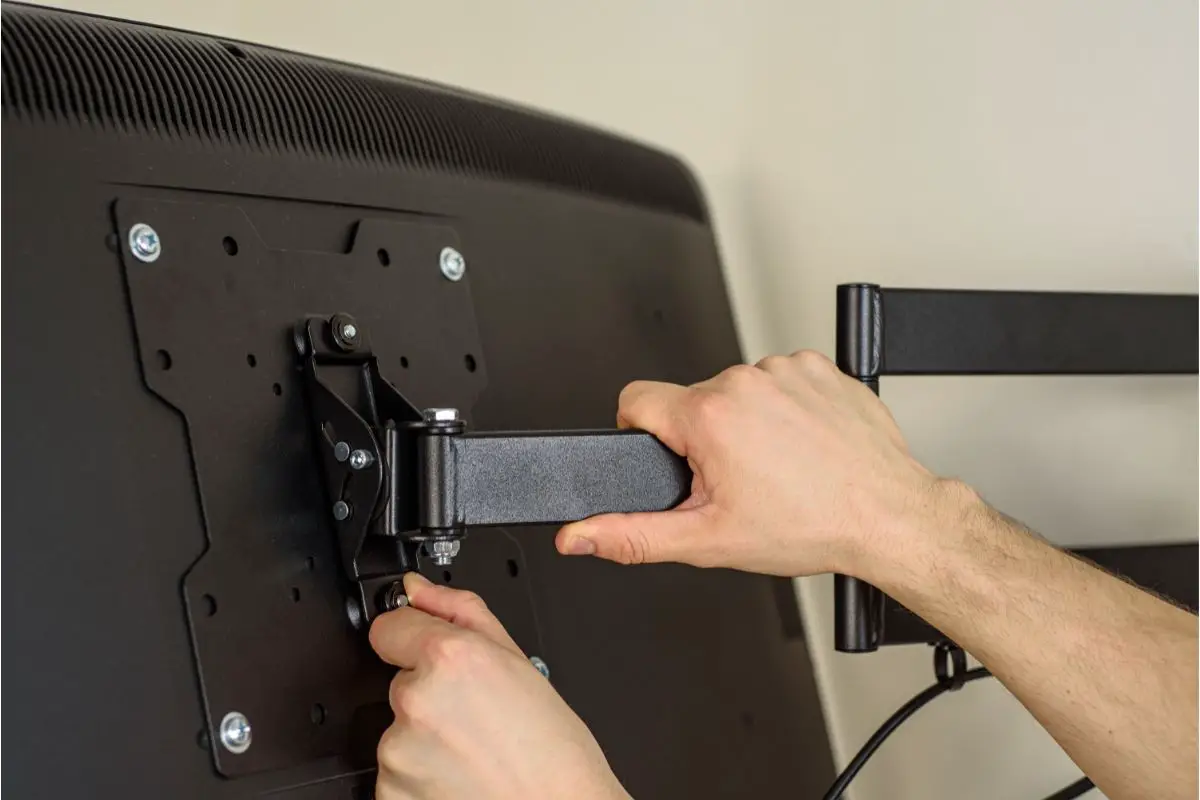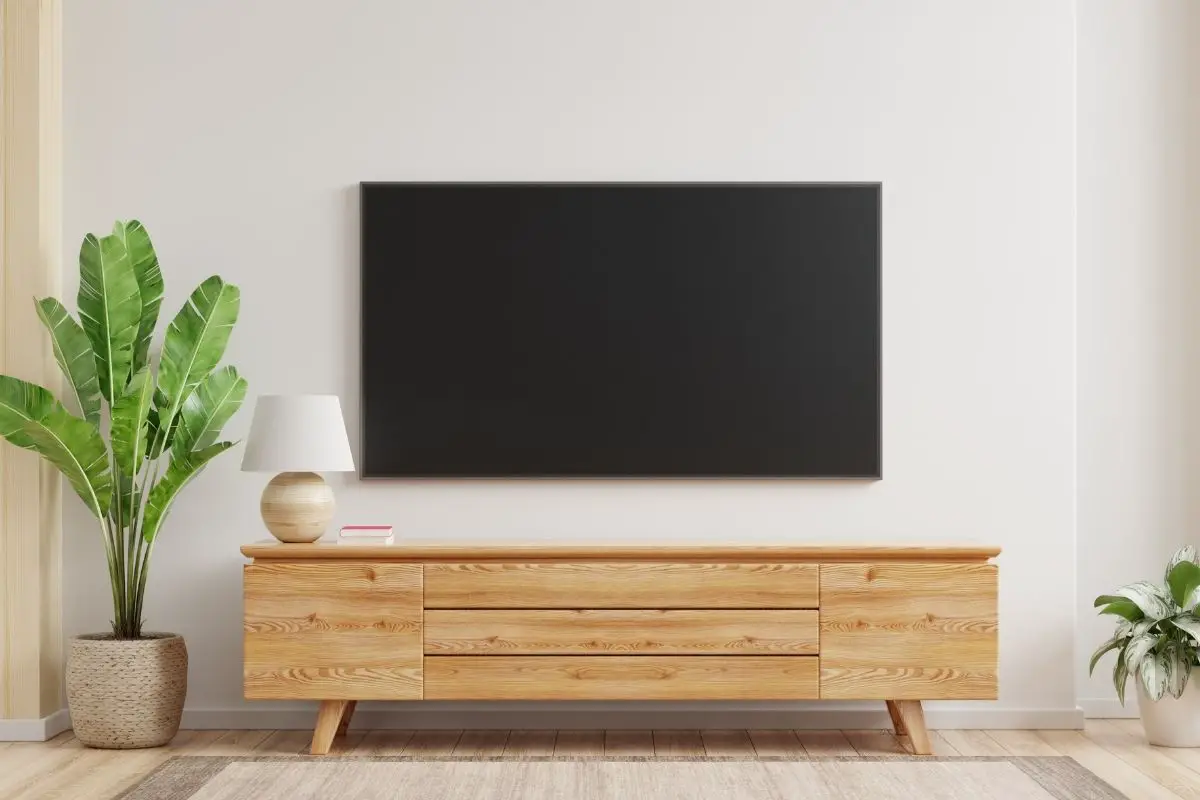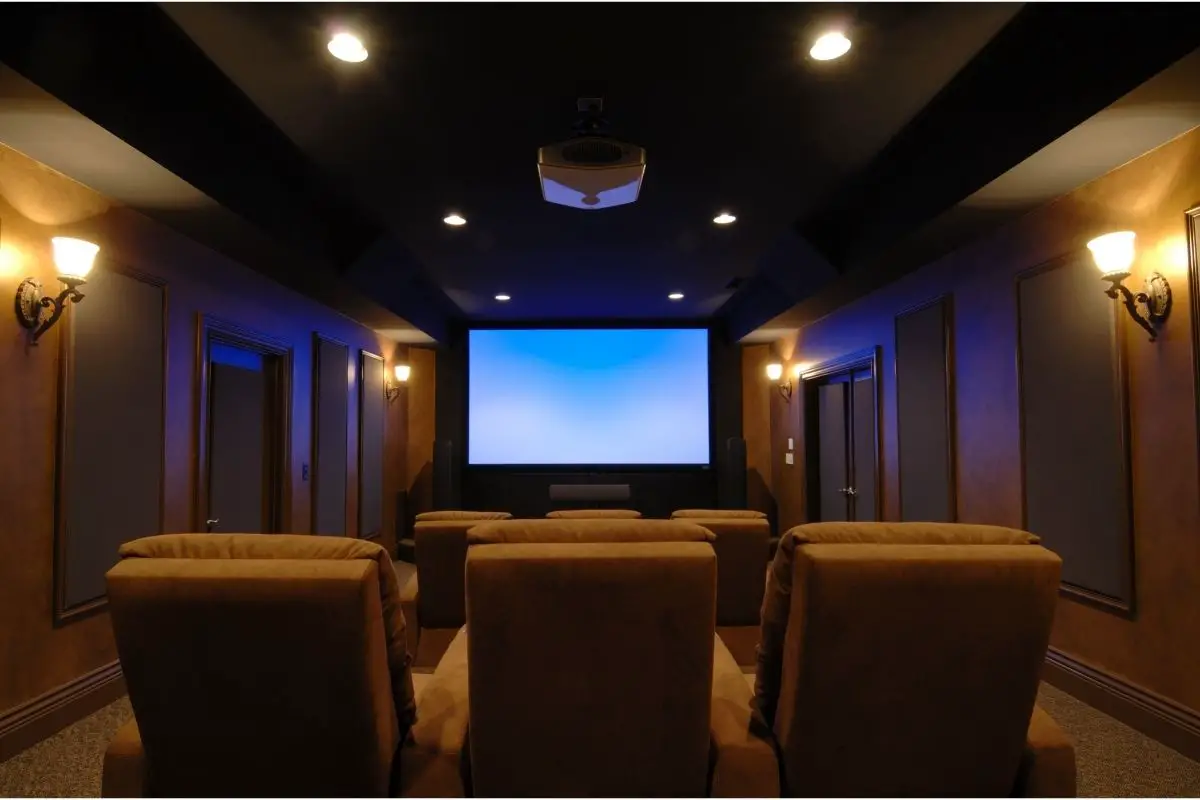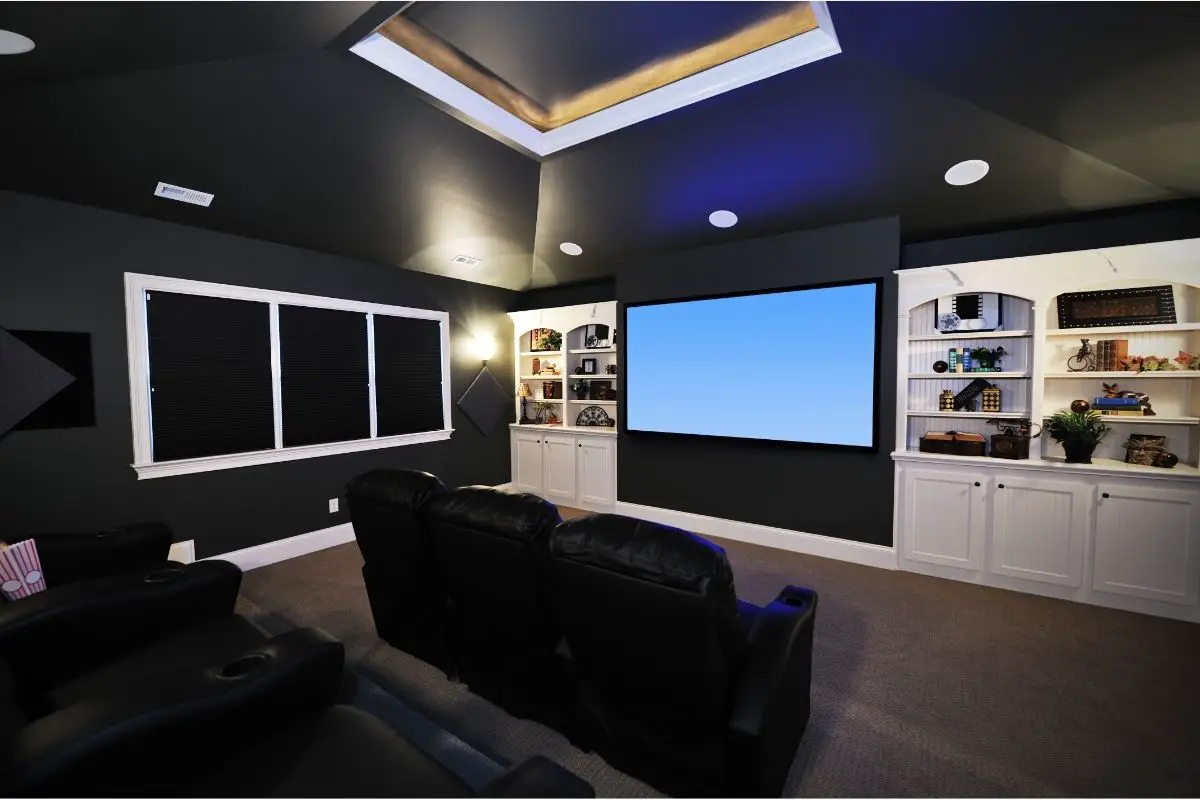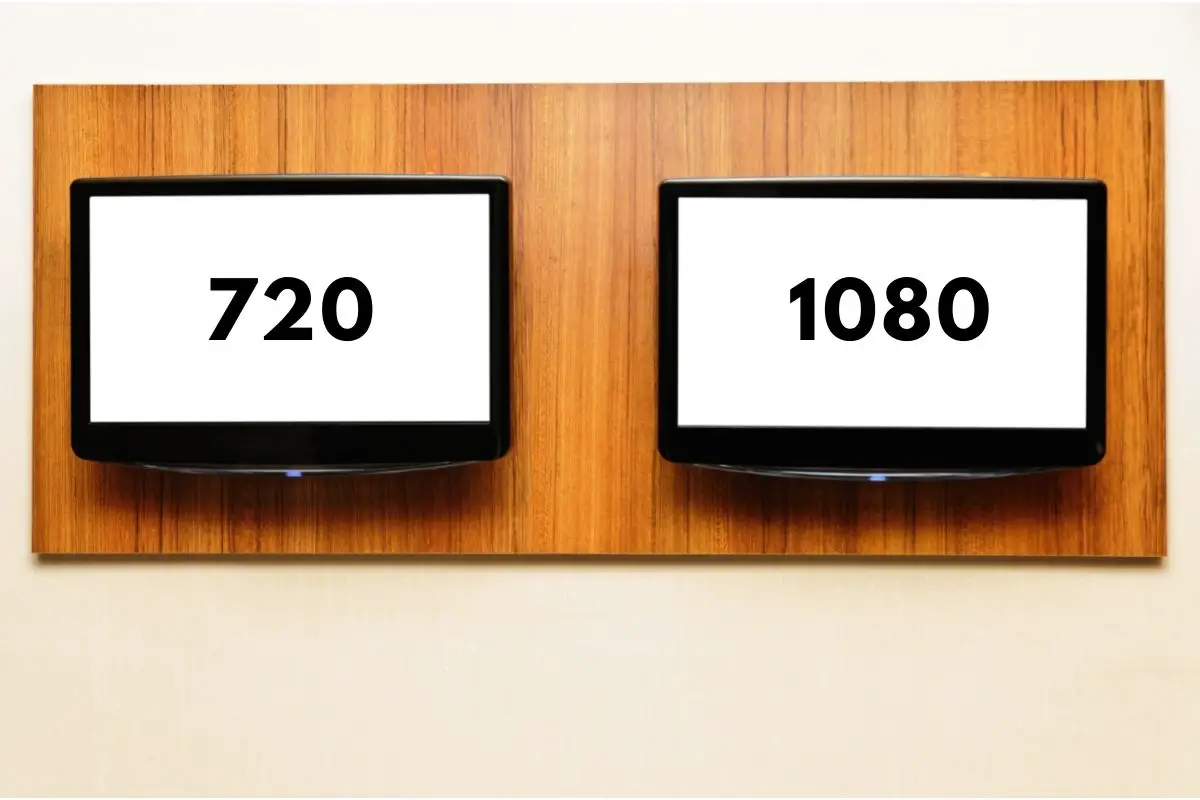A wall mounted TV is an easy way to upgrade your living room. You can get a clean and sleek look by mounting your TV on the wall. This also makes it easier to watch television while sitting down.
Wall mounts are very easy to install. You need to prepare your walls first, then use screws to attach the brackets. Then, you put the TV into the bracket.
Finally, you screw the bracket onto the wall. Simple! We’ll tell you exactly what you need to know in detail – simply read on!
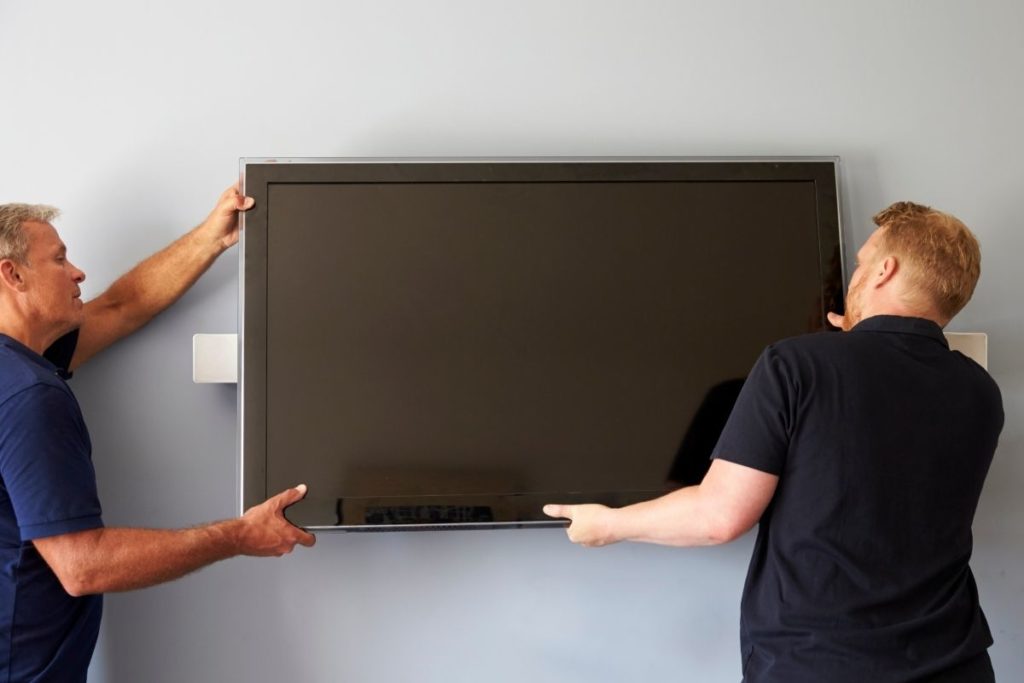
How To Mount A Flat Screen TV On A Wall
The easiest way to hang a television is by using a mounting bracket. Mounting brackets come in different sizes and shapes. You need to choose the size according to the size of your television.
Then you need to choose the shape of the bracket according to the location of the wall.
Once you know the type of bracket you want to use, you should measure the distance from the wall. This is important because if you place the bracket too close to the wall, it might damage the wall.
What You’ll Need
You should have a TV stand, paper template, pencil or masking tape, tape measure, stud finder, level, power drill, drill bit, Philips head or flathead driver, TV mount, screws, spacers, and included mounting hardware.
Some Notes On Handling TVs
A television set should be positioned carefully. It needs to be lifted by two people. You should hire an expert to do this job if you’re not confident.
A single person can handle smaller sized TVs but bigger ones require two people. Lifting a big TV could damage the screen or even break the TV. Broken TVs are hard to fix.
When handling a TV, you should always be careful to avoid damaging the display panel. You should never put any unnecessary pressure on the screen. Always use caution when moving your hands near the screen.
To lift and carry a TV properly, you should support the TV at the sides or top corners. Don’t lean the TV either way, as this could cause it to bend. Thin TVs can actually bend under the weight of themselves, causing damage to the screen.
When you set your television down, make sure it is placed on a clean, flat surface. Don’t put it on anything that could damage the screen or bezel. Also, make sure the surface is even and won’t cause any uneven pressure on any part of the screen.
TVs should be placed on flat surfaces without any twists or pressure applied.
Get The Right TV Mount
There are many different types of brackets available for mounting televisions. You can choose from a variety of styles including flush-mounts, wall-mounts, and ceiling-mounts.
Some brackets are designed for specific models of television while others are universal. Most brackets come with instructions and hardware needed to install them.
Be sure to check out our guide to choosing the perfect bracket for your TV. best TV mounts.
Wall-mounted TVs are usually placed higher than standard TVs. You need to make sure that your current TV is at an appropriate height before buying a new one.
A bigger screen means that you’ll be further away from the TV. This could mean that you’ll need to adjust the height of your couch or chair.
You should make sure you know what you’re doing when installing your new television. You need to be careful about the screws used, as well as the brackets and mounts.
A fixed TV wall mount keeps your TV in a stationary position, but you need to be careful when mounting it because if you put too much weight on it, it could break.
A swivel TV wall mount allows you to adjust the angle of your TV to view it from any direction.
Tilting TV wall mounts give you the ability to tilt the screen down for a better view when mounted higher on a wall. Wall mount TVs have full motion capabilities allowing you to manually adjust the TV right, left, up or down for a custom angle for maximum viewing pleasure.
Some models have a telescope arm, which allows you to easily move the TV around the room.
There are size and weight limits on mounting hardware. Be sure you know what size bracket you need before buying. Check the product specifications and make sure your TV is compatible with the mounting bracket.
Find The Perfect TV Position
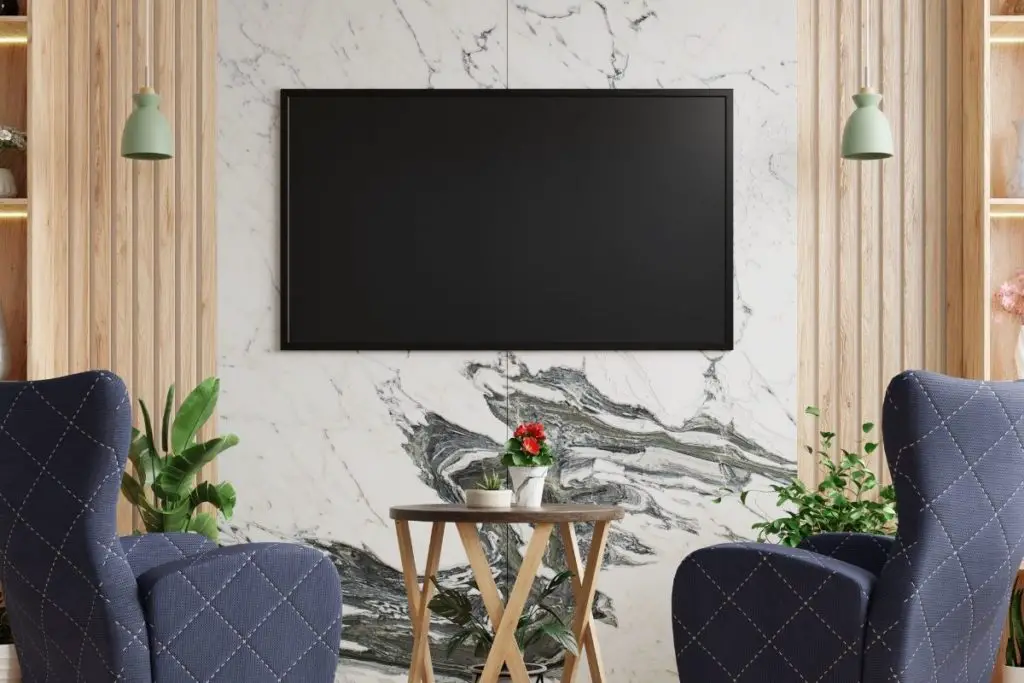
Start by finding the right wall, this will be located in a central place. The seating layout in the living room or home theater should allow you to sit comfortably while watching media.
Make sure that the wall has access to the necessary electrical outlets and any cable or Satellite connections.
Center the TV at the right distance from your eyes, with the center of the screen more or less at your eye-level.
This is where it helps to use a second helper that can help you check the comfort and angle while you and another helper hold up the actual TV. Mark the lower right or left corners with pencil or masking tapes.
Mounting brackets should be centered over the television. Wall mounts should be placed near the top or bottom of the television.
Make sure there are enough outlets nearby. Also make sure there is an easy connection for cables and other devices.
A shelf should be installed under the mounted television. The TV should be placed on top of the shelf. The shelf should be made out of wood or metal.
The TV should be supported by 4x4s. The TV should not be placed in direct sunlight. The TV should not receive any vibration. The TV should not face a heavy traffic flow.
Mounting Tips
Mounting TVs on walls is an art form. There is no right or wrong answer to the question of how high to mount your TV. However, there are some guidelines you can use to help you decide.
First, make sure the mounting hardware you choose is rated for the weight of your TV. Second, if you’re mounting your TV on a wall, make sure the wall is sturdy enough to support the weight of your TV and any additional equipment you might want to add.
Third, make sure your TV is centered over the middle of the screen. This will give you the clearest picture possible.
Fourth, make sure your TV isn’t too far away from the wall. Fifth, make sure your TV doesn’t block other windows or doors.
Sixth, make sure your TV won’t fall off the wall. Finally, make sure your TV looks good!
Mounting your TV too high or too low can cause neck strain and headaches. Find the ideal viewing position by sitting down and looking straight ahead.
Then stand up and see if you feel any discomfort. You may need to adjust your mounting height until you’re happy with the view.
Put a piece of paper or cardboard on the wall. Tape it down. Hang it up. Try looking at it from various angles. Make sure it is straight and centered. Don’t put it too high.
Locate Studs
Never mount directly into drywall without finding a stud. Drywall can’t hold the weight of even a small, light TV for very long. You’ll end up with a broken TV on the floor and a set of fresh holes in your drywall.
Screws should be used when mounting TVs on walls. Hollow-wall anchors aren’t strong enough to hold the weight of the TV. Studs are stronger than hollow-wall anchors.
Studs are two pieces of wood that hold up the TV. Mark the center of each stud with a pencil. Use nails to confirm studs have been found.
Mark Pilot Holes
Mounting holes should be evenly spaced across the wall. A level should be used to make sure the mounting holes line up perfectly.
Position The Wall Mount
A flat screen wall mount should be held up against the wall by two people. Use a level to make sure it’s even. Drill pilot holes into studs using a drill. Mark twice, cut once.
Attach The Mount To The Wall
Drill holes into the wall first. Then, use a level to make sure the mount is perfectly horizontal. Screws should be driven in halfway and then tightened completely.
Attach The Mounting Plate To The TV
Full-motion TV wall mounts may require specific steps to attach them to TVs. Follow the manufacturer’s directions when you attach the mounting plate to the TV.
Mount TV To The Wall
You need to make sure that the TV is securely connected to the wall. Ensure that you correctly follow the manufacturer’s instructions for mounting to the walls.
Double-check that the connection between the TV and wall plates is secure.
You should use an accordion cover to hide the cables hanging from the bottom of the television if they’re not installed behind the wall.
Tips To Remember
Mounting your TV is a very easy task if you follow these tips.
You should first understand what type of TV you have, then know where you want to place it, and finally, know how to attach the TV.
Studs are the wooden supports inside walls or ceilings. You should use them to attach brackets to hang things. Studs are usually spaced 16 inches apart.
Stud locations can be found by measuring the mounting points on the television. Brackets should be used to measure the distance between mounting points.
Three studs is usually enough for most TVs. Marking the stud locations with a pencil is recommended.
Screw holes should be marked on the wall by hand. A level should be used to ensure that the holes are evenly spaced.
Double-check the bracket position before you start drilling. Make sure the bracket is perfectly straight before you drill. You should use a level to make sure the mount is level.
You should drill pilot holes before you mount the wall bracket. Then, using the included mounting screws, securely attach the wall bracket to the wall.
You should tighten the screws until the bracket is snug against the drywall and doesn’t move around. Overtightening the screws may damage the drywall.
Anchors should be strong enough to hold up TVs. Make sure you check the load capacity of the anchor you choose. A large screen weighs more than a smaller one.
Wall anchors should be installed on walls made of wood, concrete, or bricks. Drywall and plaster walls are too weak to hold heavy TVs.
Should You Wall Mount A TV Or Put It On A TV Stand?
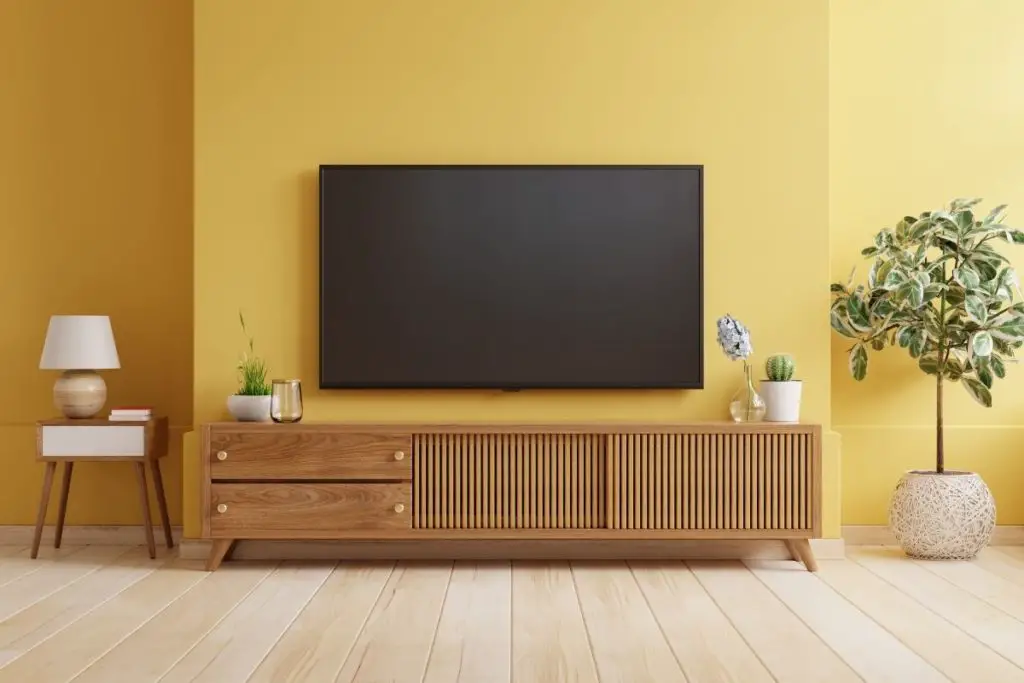
A TV mount is designed to keep your TV securely mounted to a wall. You can install them yourself using screws or adhesive mounting tape. However, this type of mounting system requires a lot of space. It also makes the TV vulnerable to theft.
A TV stand is designed to keep your television on the floor. It usually consists of a flat base and a shelf or drawer. These types of stands are easy to install and maintain. However, they’re less stable than a wall-mounted TV mount.
Wall mount TVs are great because they give you a perfectly leveled picture and you’ll have plenty of space in your living room to put things around it.
However, if you want to take your TV down, you may have trouble finding a place to store the mounting brackets.
TVs are usually mounted on walls because they’re easier to see than stands. Using stands has some drawbacks. The first drawback is that the TV covers the table. A tabletop must be available for the TV to sit on. The TV needs to be big enough for the stand.
Sometimes, the base of the stand is too wide and won’t fit into the table. The height of the TV also depends on the size of the stand. Too short of a height makes the TV too low for most people.
TVs should be secured to something to prevent them from falling over. Wall-mounted TVs are safer than stand units because they are easier to access. Falling TVs can cause accidents.
TV Mount Pros
You can save space by mounting TVs on walls. A wall mount keeps your TV safe from accidents.
A TV mount can save space by being flat, and it doesn’t take up any space when it’s mounted. Wall mounting TVs makes them easier to move around.
Wall-mounted televisions are great because they’re easy to move around and take up less space than other types of televisions. Clean lines make them an attractive choice. They also eliminate clutter and reduce the risk of tripping over cables.
Choosing the installation height will be helpful in preventing pressure on your neck or eyes. Establishing an optimal viewing distance will help mitigate this problem.
A movable mount makes adjusting for the correct height easy.
TV Mount Cons
Failure to install correctly could lead to damage to your TV. Be careful when installing your TV! You should take extra care if you’re installing your TV near large speakers or high-vibration environments. Also, you should consider hiding cables behind walls.
Flat screens are heavy, so you need to mount them properly. Wall mounting is recommended because it doesn’t damage walls and finishes if done right – but it will if you get it wrong.
Types Of Wall Mounts
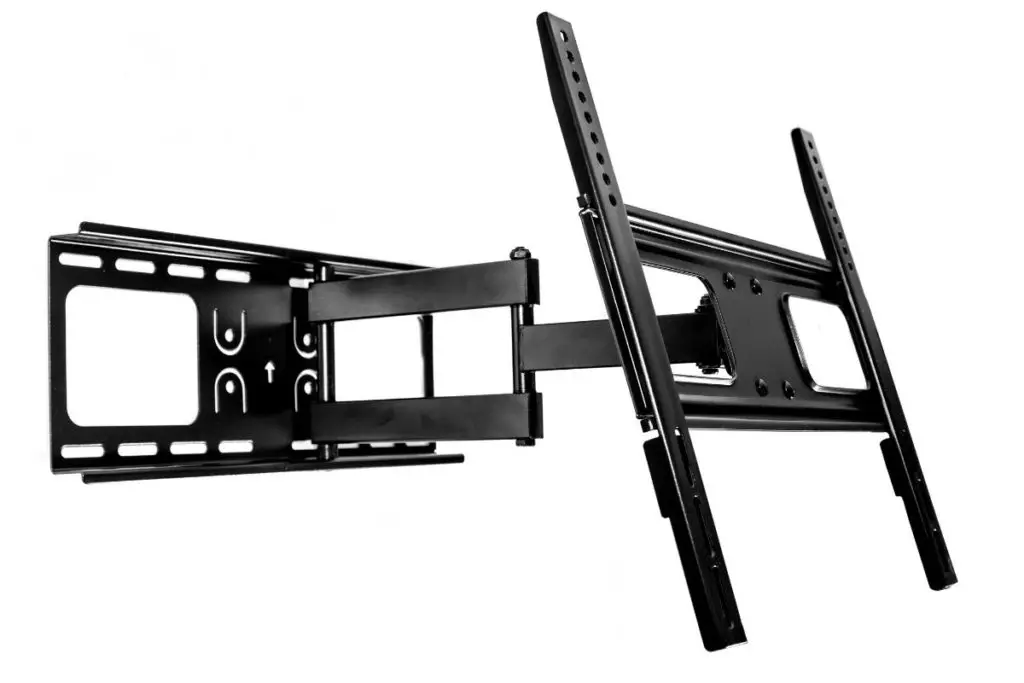
Wall mounts come in various types. Fixed mounts are simple and don’t allow any movement. Tilting mounts tilt back and forth.
Full-motion mounts move up and down as well as side to side. Cheap wall mounts are an option for people who want something simple.
Tilting mounts allow you to tilt your TV up and down. Full-motion mounts let you move your TV anywhere you want.
Conclusion
If you’re looking into mounting your TV on the wall, then hopefully our guide has helped you to do it easily and safely!
- How Do I Connect My Samsung Soundbar To Bluetooth? - February 5, 2024
- How To Connect Soundbar To TV With Optical Cable? - February 5, 2024
- How to Choose the Right Audio System for Your Home Theater Setup - April 25, 2023

